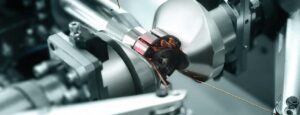FLYER WINDING
Flyer winding refers to a special process in which electric coils or windings are attached to the rotor of a flyer wheel. A flyer wheel is a rotating device used in spinning and textile machines to spin fibres.
When winding flyers, thin copper wires are usually wound around the rotor of the flyer wheel. These windings are used to create the magnetic field required to operate the flyer wheel and generate torque.
The winding process requires precision and care, as the windings must be arranged evenly and closely around the rotor to ensure optimal performance. The windings are usually applied in multiple layers, with each layer insulated to prevent short circuits or unwanted electrical interactions.
Winding of flyers can be done manually or with the help of automated winding machines. With manual winding, an experienced winder takes on the task of winding the wire evenly and precisely around the rotor. Automated winding machines, on the other hand, can perform the winding process more efficiently and quickly by automatically unwinding the wire, creating the required windings and applying the insulation.
The quality of the winding is crucial as it has a direct impact on the performance of the flyer wheel. Faulty winding can lead to imbalances, vibrations or loss of power.
Winding of roving frames is an important step in the production of spinning and textile machines. Correct and precise winding ensures efficient and reliable functionality of the flyer wheel and contributes to the high-quality production of yarns and fibres.

